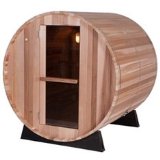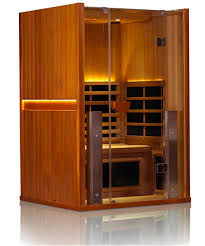Sauna Heaters – Which One Should You Choose?
Though the tradition of sauna bathing has spread across the globe, it originated in Finland where the earliest type of saunas were nothing more than shallow fire pits dug in the ground covered by two or three layers of stones to heat the sweat huts. Water would be thrown on the stones to produce humidity, allowing bathers to enjoy the cleansing benefits of working up a sweat.
In fact, the word “sauna” is actually a Finnish term meaning “bath” or “bathhouse”, and it is believed to be derived from another Finnish term, “savuna”, meaning “in smoke”. This refers to the earliest saunas which used the smoke from a wood fire to heat the room. After the room reached maximum heat, the smoke was then allowed to clear before the bathers entered.
The first wooden sauna cabins were built in Finland in the fifth to eighth centuries and in the 1700’s a metal woodstove with a chimney was first incorporated into these saunas. Since then, the sauna stove has evolved from wood-burning fires, to modern electric and gas heaters, and even to futuristic infrared technology.
No matter which type of heater you opt for, the benefits of saunas are hard to deny. As the pores open and the body sweats, it is cleansed of toxins while the heat causes an increase in heart rate similar to exercising.
Over the years, sauna bathing has been linked to the treatment of a number of conditions from arthritis and muscle inflammation to coronary disease. In fact, a 2018 study showed that sauna bathing clearly reduced the risk of stroke in Finnish men and women.
So it’s not surprising that sauna use continues to be so popular. With many more individuals opting to install a sauna in their home, choosing the right type of sauna heater is more important than ever.
There are several factors which should be taken into consideration when evaluating the many options available in sauna heaters, including cost, functionality and the location and size of your sauna and several pros and cons associated with each type.
Let’s take a brief look at the different sauna stoves:
Your Sauna Heater Options

1. Wood-Fired Sauna Heater
Sauna purists consider wood stoves as the only true and traditional sauna experience. As noted above, wood fires were the first method for heating saunas and the original saunas would incorporate the smoke from those fires, taking nearly a full day for the smoke to fully heat the sauna room before it could be cleared out and bathing could begin.
Let's take a look at the pros and cons of wood sauna heaters...
Pros:
· They provide a much more natural experience and the sight and sound of the fire can add to the ambience.
· They are ideal for outdoor saunas and portable saunas that don’t have a direct connection to a power supply.
· Typically, they are the least expensive option for sauna heating, particularly if you have ready access to a natural supply of wood.
Cons:
· They are for outdoor saunas only, unless your indoor sauna has an approved insulated chimney and it is permitted by your home owner’s insurance.
· Wood-fired heaters take longer to heat a room and they can make it more difficult to control the temperature.
· If wood is not readily available, purchasing it can be costly, running anywhere from $300 to $600 a cord depending on the type of wood.
· They require a chimney for venting.
If you can use a wood-fired heater in your sauna, find one that has a glass front so you can enjoy watching the fire as well as the heat and steam from the rocks.
In general, wood burning and smoke sauna heaters are the most affordable type, ranging from $210-$260 for a unit and since they don’t rely on your home’s heating system, they also won’t cause a spike in your utility bills, which makes them even more appealing to most homeowners.
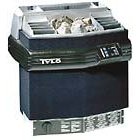
2. Electric Sauna Heater
First introduced in the 1950’s, electric heaters are the most popular and readily available type today. In an electric heater, the volcanic rocks sit on the top tray just like on the wood burning sauna stove and you can pour water directly on them for the steam effect.
Since there is no wood involved, electric heaters won’t produce any smoke, which can make the experience more comfortable, and they don’t require a chimney for venting.
The stove is encased so there’s no chance of any electric shock by water getting to the heating elements. This heater can also be used without water for a hot dry air sauna experience.
Let's take a look at the pros and cons of an electric sauna heater...
Pros:
· Electric heaters are clean, convenient and easy to use, which may allow you to use your sauna and enjoy its many benefits more often.
· They are relatively quick to heat up and some models can even be pre-programmed so that your sauna is ready to use whenever you want.
· Many electric saunas have built in safety features including an automatic reset after an hour of use, which can help to avoid overheating.
· Since they are the most popular type of sauna there is a wider variety of options available to consumers.
Cons:
· They must be connected directly to your electric heating system, meaning sauna use will directly affect the amount of your utility bill.
· If you live in a more rural area without direct access to a good electrical system, it may be impossible for you to use an electric heater.
Aside from driving up your utility bills, the cost of most electric saunas ranges from $600-$2,640 so they can be slightly more cost prohibitive.
Compare Prices of Popular Sauna Heaters at Amazon
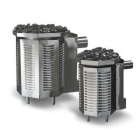
3. Propane or Natural Gas Stoves
A natural gas or propane heater is similar in hook-up to a gas fireplace. Although it is more costly to buy than an electric heater, it is less expensive to operate and it will heat up the sauna faster.
A gas stove will require a licensed electrician if you have a piezo ignitor but not for standing pilot and HVAC professional to hook it up to your home gas line but if your home already uses gas heat, this is the way to go.
Let's look at the pros and cons of propane and gas heaters...
Pros:
· Much like a gas stove, a gas or propane sauna heater heats up more quickly than its electric counterpart. It will also cool down more quickly after it is shut off. This makes it much easier to control the heat level.
· Since it does not require electricity (standing pilot only, piezo ignitors require electricity), a natural gas or propane heated sauna can continue to operate during a power outage, which is an added convenience.
· A cost-efficient option in the long run as it won’t drive up your utility bill
. Easy to operate time and temperature controls like electric heaters but without costly element replacements and temperature fluctuations of wood heaters
· More efficient and emits a softer, more comfortable heat than electric heaters.
Cons:
· The initial costs of gas/propane sauna heaters are much higher than those for electric or wood heaters, though the long term cost benefits can eventually make up for this.
· May corrode over time, which can be a particular concern for outdoor saunas.
. Since natural gas heaters have to be connected directly to your home’s gas line, they cannot be used for mobile or remote units. Propane heaters, on the other hand, are more flexible and can be used in more remote locations and in mobile applications.
In general, gas heaters are more expensive, ranging from $3,000-$4,500

4. Infrared Heating Elements
The newest addition to the sauna experience, Far infrared ray (FIR) sauna heaters have some health advantages over traditional steam saunas, and they are even less expensive to operate than a gas fired sauna stove.
Instead of one large heater with hot rocks, this technology involves several small heat emitters located strategically around the room, and the sauna operates at a lower temperature.
One drawback though is that the löyly - the steam created by throwing water on the hot rocks - is not possible in a 100% infrared heated sauna. Many sauna purists believe that the löyly is essential to the sauna experience, and therefore do not feel that infrared saunas should be classified as saunas at all.
Unlike traditional saunas, an infrared sauna works by warming the body from within, rather than warming the air around you. It’s much the same as the way your body warms up when you are exposed to sunlight. Because it is coming from within, the effects of an infrared sauna can be even more dramatic, allowing you to sweat out approximately 20% toxins as compared to just 3% toxins in traditional saunas.
At the same time, an infrared sauna works at a lower temperature, allowing you to use it for longer sessions. All of this adds up to even more proven health benefits, including the ability to enhance the benefits of exercise, which makes this a popular choice among athletes. A recent study in particular showed the benefits of far-infrared sauna use for recovery from strength and endurance training sessions.
One thing you’ll want to keep in mind when shopping for residential sauna heaters is the warm-up time. A sauna stove can take as long as 40 minutes to warm up, which is one reason so many sauna users opt to get a far infrared heater, which will heat up to the correct temperature (up to 140° F) in as little as 10 minutes.
Let's look at the pros and cons of infrared sauna heaters...
Pros:
· Since they don’t rely on heating up the room and they operate at a lower temperature than traditional saunas, infrared saunas can reach maximum heat much faster.
· Heating your body from within, they can provide a much wider range of health benefits, particularly for athletes and those with certain medical conditions including arthritis, high blood pressure and muscular inflammation.
· Much less expensive to operate than other types of heaters, including gas and propane.
Cons:
· Doesn’t use water so there is no traditional steam experience, which many sauna purists prefer.
· They work off of your home’s electrical system so they will not operate during a power outage.
· They don't reach the temperature of other sauna heaters, so if you like higher temps they might not be the best option for you.
An infrared heater can be relatively inexpensive at $450-$600, making it one of the more affordable options available.
Bottom Line on Sauna Heaters
As you can see, there are pros and cons to each type of sauna heater, so it is important to do your homework and consider all of your options before choosing one. With a little knowledge you’ll be able to determine the best possible stove for your home sauna as well as your budget.
We review some of the more popular ones below if you want to learn more about how they work and what makes one better than another.
Sauna Heater Reviews
Swedish Sauna Stoves Made by Tylo - Outstanding safety features include a thermo-safe design that offers a low surface temperature.
Polar Sauna Stoves - Gentle Heat and Steam - Beautiful red enamel exterior makes these stoves very attractive.
Heat Your Sauna with a Vico Propane Sauna Heater - Less costly to operate and lasts substantially longer than an electric heater.
Infrared Saunas
Sauna Heaters
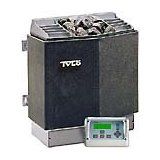
How to Install a Wood Sauna Heater
Sauna Kits
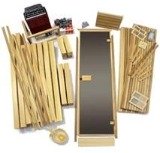
Buying Guide
